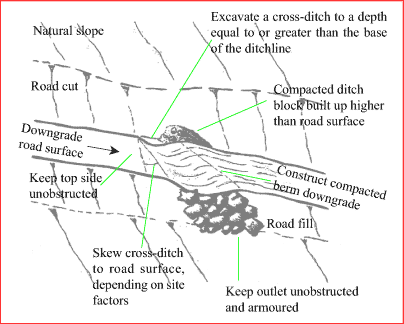|
Forest Road Deactivation Practices
|
|
in the Pacific Northwest
|


|
|
| 9 - Cross-Ditches (Road Intact)
|
Description, Expectations |
Base Preparation for Pipe Culverts
Description
Cross-ditches are used to capture road surface and ditchline water,
and route it off and across the road to stable, non-erodible sites below
the road. Properly installed cross-ditches and good ditch blocks
should not require maintenance to ensure their effectiveness of long-term water management objectives.
Expectations
- Excavate the entire cross-ditch to a depth equal to or greater than the depth of the ditch at the cutslope. Do not rely on the berm (3 below) to hold the water in the cross-ditch.
- Skew cross-ditches and allow sufficient gradient to ensure free water flow. The amount of skew depends on road gradient, source, outlet location and anticipated flows, but is typically between 20 and 30 degrees; avoid sharp changes in flow direction.
- Place the excavated cross-ditch material parallel to the excavation on the downslope side and compact it well to create a berm. Fine-textured materials such as silts should not be used as a berm but rather placed outside the road prism or against the cutslope without interfering with water flows. The upslope side of the cross-ditch must be unobstructed to accommodate road surface water runoff.
- Construct a well-compacted ditchblock directly below the cross-ditch to ensure that the ditch water is directed into the cross-ditch. 5. Ensure that inlets and outlets are unobstructed . Pull back materials from the outlet area as well as from the road shoulder.
- Construct the cross-ditch deeper at the fillslope side to ensure a downhill grade.
- Do not direct water onto erodible or unstable slopes.
- Use rock or other materials to provide erosion protection at the outlet. In erodible soil, you must also armour the base of the cross-ditch without obstructing or diverting water flows.
- Make sure that location, depth and width of cross-ditches are consistent with access management objectives for the area.
Figure 2: Cross-Ditch

Remember the rule of thumb: a cross-ditch should be at least five times wider than it is deep.
| 9 - Cross-Ditches (Road Intact)
|
Cross-Ditches (Road Intact) 9 
|
|
©1999 - 2002 Flip Productions Limited
Used with permission by CulvertBC
|
